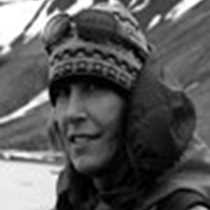Endicott Arm and Williams Cove
It’s hard to beat a day that begins deep in the reach of Endicott Arm, glacier-scoured walls rising high on either side, the water milky with glacial flour. Even a bit of rain couldn’t dampen the view. In fact, the low-slung mist and clouds may have enhanced it, allowing the fjord walls to rise a bit more mysteriously and the shattered blue face of Dawes glacier to glow a bit more fiercely.
Growlers clunking along the hull, arctic terns winging along with us, we edged up toward the glacier face and let it fill our view during breakfast. We spent the remainder of the morning deciphering the geologic history of Endicott Arm as we made our way out to its mouth. A few harbor seals were hauled out, resting on the floating ice, lifting their wide-eyed heads to watch us pass. Other harbor seals popped up in the water, some of them mothers with pups just a few days old. In fact, on one piece of ice, we saw a pup so young that its pink umbilical cord was still visible as it lay on its side next to its mother. That such a new thing could live among such old rocks is nothing short of amazing.
Kevin and Kristen, National Forest Service Wilderness Rangers, allowed us to lift their kayaks onto the Sea Lion. They shared with us their life and work in the Tracy Arm/Ford’s Terror National Wilderness Area: camping and paddling, counting harbor seals, taking samples of lichen to test air quality, and generally connecting visitors to this beautiful, wild place.
After ducking into Ford’s Terror to see the dramatic currents and plentiful birds that take advantage of its turbulent water, we proceeded to Williams Cove. A protected bay near the head of Endicott Arm, Williams Cove was the ideal spot to first set ashore and stretch our legs over hemlock roots or poke along the shoreline in a kayak. Bear scat aplenty and birdsong—both over the water and in the trees—gave hint of what Southeast Alaska still has to reveal to us. We left full of the day’s riches, eager to see what the next day would bring, and the one after that, and the one after that.
It’s hard to beat a day that begins deep in the reach of Endicott Arm, glacier-scoured walls rising high on either side, the water milky with glacial flour. Even a bit of rain couldn’t dampen the view. In fact, the low-slung mist and clouds may have enhanced it, allowing the fjord walls to rise a bit more mysteriously and the shattered blue face of Dawes glacier to glow a bit more fiercely.
Growlers clunking along the hull, arctic terns winging along with us, we edged up toward the glacier face and let it fill our view during breakfast. We spent the remainder of the morning deciphering the geologic history of Endicott Arm as we made our way out to its mouth. A few harbor seals were hauled out, resting on the floating ice, lifting their wide-eyed heads to watch us pass. Other harbor seals popped up in the water, some of them mothers with pups just a few days old. In fact, on one piece of ice, we saw a pup so young that its pink umbilical cord was still visible as it lay on its side next to its mother. That such a new thing could live among such old rocks is nothing short of amazing.
Kevin and Kristen, National Forest Service Wilderness Rangers, allowed us to lift their kayaks onto the Sea Lion. They shared with us their life and work in the Tracy Arm/Ford’s Terror National Wilderness Area: camping and paddling, counting harbor seals, taking samples of lichen to test air quality, and generally connecting visitors to this beautiful, wild place.
After ducking into Ford’s Terror to see the dramatic currents and plentiful birds that take advantage of its turbulent water, we proceeded to Williams Cove. A protected bay near the head of Endicott Arm, Williams Cove was the ideal spot to first set ashore and stretch our legs over hemlock roots or poke along the shoreline in a kayak. Bear scat aplenty and birdsong—both over the water and in the trees—gave hint of what Southeast Alaska still has to reveal to us. We left full of the day’s riches, eager to see what the next day would bring, and the one after that, and the one after that.




